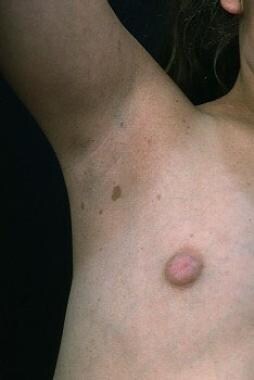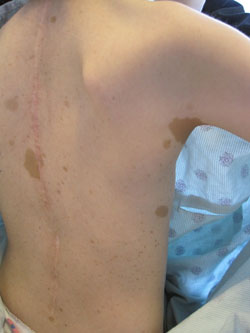Cafe au lait spots
The name café au lait is French for "coffee with milk" and refers to their light-brown color. They are caused by a collection of pigment-producing melanocytes in the epidermis of the skin. These spots are typically permanent and may grow or.
Developing a spot on your body can be a cause for concern. Throughout childhoo the spots can increase in size, number and darkness.

By the age of 2- the spots are usually clearly visible. The pigmented lesions can be smooth or raised and range in color from beige to dark brown. In light-skinned individuals, they are the color of coff. See full list on firstderm.
Having one to three spots is common and no treatment is necessary. However, any child with six or more café-au-lait spots that are more than 5mm in diameter should be monitored and treated as having neurofibromatosis.
Siblings of the child should be evaluated as well, as neurofibromatosis is a genetic disorder.
In newborn children, the spots are difficult to see. A physician can use a Wood’s lamp to visualize these faint spots. Without treatment, café-au-lait macules persist lifelong.
Although thefrom lasers are not consistent, recurrence rates are low once removed. Ask a dermatologist today if you have concerns about your skin Source:DrGreene. The diagnostic and clinical significance of café-au-l. The borders may be smooth or irregular.
Cafe au lait spots. In patients with multiple cafe-au-lait spots it is important to obtain a family history of similar lesions or disorders known to be associated with cafe-au-lait macules. Characteristic findings on physical examination. However, they may be associated with syndromes such as Neurofibromatosis Type and McCune-Albright syndrome.
Finn Beste Pris På Alle Dine Varer. The incidence of single lesions is high and of no significance – a patient is allowed up to four patches of less than 0. For example, or more cafe au lait spots (CALMS) and freckles in the armpits, or or more CALMS and Lisch Nodes on their iris, or or CALMS and a plexiform neurofibroma.
However, when the child has only cafe au lait spots, we need to carefully examine the characteristics of the spots to find out if they are the spots typically found in NFor if they are atypical spots, that is, they are. Objectives After completing this article, readers should be able to: 1.

Define café au lait spots typical of neurofibromatosis type (NF1) and describe their frequency and variability in the normal population. List three or more genetic disorders other than NFthat are associated with café au lait spots.
Tekin M, Bodurtha JN, Riccardi VM. De Schepper S, Boucneau J, Vander Haeghen Y, Messiaen L, Naeyaert JM, Lambert J. De varierer i størrelse fra noen få millimeter til cm. Fargen varierer fra lysebrun til mørkebrun. The photos of cafe au lait spots in adults below are not recommended for people with a weak psyche!
We wish you a cure and never get sick of this disease! An underlying genetic disorder should only be sought when such spots are multiple. However, in the case of McCune-Albright syndrome, it is the irregular borders and the Blaschko-linear arrangement of the spots in broad irregular bands that are pathognomonic, reflecting as they do the genetic mosaicism characteristic of.
Some babies have them at birth, but they can also develop during early infanthood. The spots can occur in all skin tones, though they seem to affect Black babies slightly more often. Often present at birth, they become apparent during the first few years of life.
They are flat birthmarks and size can range from 1-millimeters to even centimeters. Many patients have dysmorphic features suggestive of Marfan syndrome including a typical habitus, pectus excavatum, scoliosis, and pes cavus. Round or oval patches of light-brown pigmentation frequently present at birth. They often increase in number and size with age, and may occur anywhere on the body.
They are found in per cent of normal individuals, but they may also be associated with neurofibromatosis or other neurocutaneous diseases. In neurofibromatosis, the café- au – lait spots tend to be more numerous and larger.
I have quite a few cafe au lait spots. At the cellular level, they are characterized by an epidermal hypermelanosis with a normal number. About 10% of the general population have cafe au lait spots.